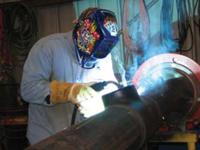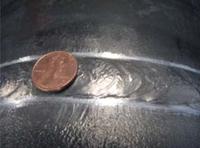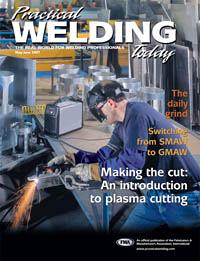- FMA
- The Fabricator
- FABTECH
- Canadian Metalworking
Categories
- Additive Manufacturing
- Aluminum Welding
- Arc Welding
- Assembly and Joining
- Automation and Robotics
- Bending and Forming
- Consumables
- Cutting and Weld Prep
- Electric Vehicles
- En Español
- Finishing
- Hydroforming
- Laser Cutting
- Laser Welding
- Machining
- Manufacturing Software
- Materials Handling
- Metals/Materials
- Oxyfuel Cutting
- Plasma Cutting
- Power Tools
- Punching and Other Holemaking
- Roll Forming
- Safety
- Sawing
- Shearing
- Shop Management
- Testing and Measuring
- Tube and Pipe Fabrication
- Tube and Pipe Production
- Waterjet Cutting
Industry Directory
Webcasts
Podcasts
FAB 40
Advertise
Subscribe
Account Login
Search
Blasting the bottleneck blues
Mechanical contractor increases pipe welding productivity 500 percent
- May 8, 2007
- Article
- Arc Welding
For Farmer & Irwin Corp., a mechanical contractor based in Riviera Beach, Fla., increasing the productivity of its HVAC pipe fabrication shop was more than just a good idea, it was a necessity.
Founded by R.E. "Bob" Farmer and R.R. "Dick" Irwin in 1956, the company is committed to meeting its deadlines in a cost-effective manner and with high-quality workmanship. These traits have allowed the company to grow into a multifaceted mechanical contractor with 276 employees serving the plumbing, HVAC, fire sprinkler, and sheet metal industries.
Roughly 90 percent of the company's HVAC work consists of fabricating carbon steel chilled-water pipe from 11⁄4 to 16 inches for air-conditioning systems in schools, malls, and office buildings.
HVAC Superintendent Larry Wrye attributes the company's success to its ability to change with the times. "We're always looking for ways to improve our production process and material handling," he said.
One of the ways the company changed with the times was by adopting lean manufacturing principles. Improvements have included reducing the number of steps required in its pipe fabrication process and improving material flow through the facility and on job sites by loading parts on carts.
As a result of these lean techniques, the company identified a bottleneck in work flow at its welding station. The welders could not weld pipe as fast as the fitters could prepare it, creating downtime among the fitters.
Ch-Ch-Changes
Farmer & Irwin determined that the process was to blame for the bottleneck and not the fitters, welders, or production managers. Like most fabricators, the company used shielded metal arc welding (SMAW) to weld Schedule 40 carbon steel pipe in a fixed position. Joints were completed in three passes using 1⁄8-in.-dia. E6010 electrodes for the root pass and 3⁄32- and 1⁄8-in.-dia. E7018 electrodes for the fill and cap passes.
The company said it tried conventional short-circuit gas metal arc welding (GMAW) in the past to speed up production, but the technology never resulted in acceptable welds. As a result, the company continued using SMAW.
"We tried wire welding with a few different arrangements … but we always ended up with excessive penetration, which caused keyholes and stalactites on the inside of the pipe," Wrye said.
Under the old system, top welder Joe Mangola would be backed up for days with pipe that was fitted, tacked up, and ready to be welded, leaving the fitters with downtime. Mark Moebius, a Praxair representative who had worked with Farmer & Irwin for 30 years, thought he knew what to do when Wrye approached him with the company's dilemma.

Farmer & Irwin made the switch from SMAW to GMAW and increased production rates by 100 percent on 3-in.-dia. pipe and up to 500 percent on 12-in.-dia. pipe.
Moebius suggested the PipePro™ 450 RFC, a new system from Miller Electric Mfg. Co. with Regulated Metal Deposition (RMD™) for root passes and ProPulse™ for fill and cap passes. The PipePro, specifically designed for pipe fabrication, has an output of 450 amps/44 volts at 100 percent duty cycle. Using the RMD process, the system can achieve quality GTAW root pass welds at more than twice the travel speed and with substantially less operator training time and operator repositioning than SMAW, according to the company.
RMD is a modified short-circuit transfer process that precisely controls welding current during all phases of metal transfer to help eliminate excess weld puddle agitation. The system can sample and adjust arc variables up to 10,000 times per second to create consistent and predictable arc conditions. It also provides a calm weld puddle, which helps novice welders learn quickly.
A calm weld puddle produces consistent fusion lines (eliminates cold lap) on a pipe root pass, so welds pass inspection the first time. Cold lap occurs when molten metal splashes against the side wall of the pipe and "freezes" on top of it (instead of penetrating and fusing with the base metal). A calm weld puddle also promotes higher deposition rates. In some cases, RMD eliminates the need for a hot pass, which can save $15 per weld on a 12-in.-dia. Sch. 40 pipe. RMD can eliminate the excessive positive (convexity) reinforcement and "whiskers" inside the pipe, which is what Wrye meant when he referred to stalactites inside the pipe.
RMD also produces a fast-freezing weld puddle by removing a critical amount of energy during the "blink" stage. A fast- freezing puddle tolerates gaps well because the weld metal stays where it is directed. Operators can make sound welds, even when fit-up is less than optimal. Last, the RMD process reduces heat input 5 percent to 20 percent compared to traditional short-circuit GMAW, according to Farmer & Irwin. This can solve problems in heat-sensitive applications such as welding stainless steel.
ProPulse technology controls both current and voltage to stay within the optimal range for a specific wire type and diameter, wire feed speed, and gas combination. The control scheme starts by ramping up the current. Once the target current is reached at the beginning of each phase, the constant-current (CC) control turns off and the constant-voltage (CV) control loop turns on. The CV loop modulates the current within a range that maintains the target voltage. This occurs independently of the contact-tip-to-work distance.
The operator can achieve nearly ideal weld parameters simply by selecting the wire type, wire diameter, gas combination, and desired process. The system then uses that information to select the optimal parameters from a library of application programs. Also, both processes can use a common shielding gas, either C10 or C15, when welding with an E70 electrode.
Moebius said he thought his company's newest generation of GMAW pipe welding technology would work well for Farmer & Irwin's situation because it would address puddle and arc control issues and eliminate rework. Moebius coordinated a demonstration that consisted of welding 4-in. and 6-in. Sch. 40 carbon steel pipe so Wrye could experience the new technology firsthand. The welding system consisted of the multiprocess power source; a dual wire feeder for different wire diameters—0.035-in.-dia. ER70S-6 solid wire for the root pass and 0.045-in.-dia. solid wire for the fill and cap passes—a 90/10 argon/CO2gas mix for all processes; and 250- and 400-amp, air-cooled GMAW guns.
"The techniques for welding with the new processes are basically the same as with conventional short-circuit or spray GMAW," said Bob Rezac, shop foreman.
By technique, Rezac refers to electrode stick-out, gun angle, travel speed, and weld puddle manipulation. Proof that the new processes were easy to learn came when Farmer & Irwin's initial welds passed visual inspection and pressure testing.
"We have welded a lot of pipe now, and the new processes definitely produce good fusion on both sides of the pipe," added Mangola.
Productivity gains were immediately evident. The GMAW process increased travel speeds and deposition rates. For example, on a GTAW root pass, the weld bead typically has a concave profile (it sags slightly in the middle). With RMD, the typical weld bead has a flat profile, and it may deposit enough weld metal to eliminate the need for a hot pass and enable the operator to move directly to the fill or cap pass.
With deposition rates of more than 3 pounds per hour for 1⁄8-in. E7018, the pulsed GMAW improves productivity and requires little or no postweld cleaning.
In less than 60 seconds, Mangola said he can switch between the welding process used for the root pass and the welding process used for the remaining passes by turning a knob and pressing a few buttons on the software-driven system.
Learning Curve
Making the transition to the new technology wasn't completely seamless. With many different pipe diameters to weld, Mangola and Rezac had to determine the best weld parameters, which is a lengthy process of writing down parameters for each weld and inspecting each weld's quality against that of other parameters tested. To address this shortcoming, the equipment manufacturer now recommends starting parameters.
Farmer & Irwin also learned that brass GMAW gun nozzles cannot handle the high heat settings Mangola prefers—wire feed speeds of more than 250 IPM—for the fill and cap passes. After prematurely burning through a few nozzles, Mangola contacted Moebius, who recommend copper nozzles. Copper dissipates heat better than brass, so it lasts longer in high-heat applications. The manufacturer now ships the gun with copper nozzles as standard.
The SMAW process tolerates contaminants, such as paint, better than solid-wire pulsed GMAW. As a result, Rezac said the company learned that it needed to clean the pipe to eliminate porosity and other weld defects. It uses a grinder or flap wheel to clean at least 11⁄2 in. back from the edge of the joint.
Rezac also pointed out that different brands of GMAW wire performed differently, so they performed testing on a few before settling on the preferred wire. Further, he noted that using the wrong gas mixture caused confusion. A 90/10 argon/CO2gas mix works well for both the modified short-circuit GMAW and pulsed GMAW processes. A 75/25 mix works well for short-circuit GMAW, but any pulsed GMAW process requires an argon content of at least 82 percent, or a maximum content of 18 percent CO2.
One of the last lessons learned is that welding pipe in position is not as productive as rolling it, so Farmer & Irwin paired the new welding system with a positioner-gripper that clamps the pipe in a fixed position and rotates it on an axis, allowing the welder to maintain a continuous flat (1G) position. The positioner-gripper helps to increase overall productivity by allowing the welder to use the highest possible wire feed and current settings for the wire and material being welded, as well as reduces the number of times the welder has to stop and reposition himself.
Bottleneck Removed
While learning the new welding processes took just a few hours, transforming Farmer & Irwin from a traditional SMAW shop to one that uses advanced GMAW processes required about two weeks of hard work. The company relied heavily on technical support from its welding supply distributor, welding equipment supplier, and from its workers. The results have been well worth the effort, the company said.
It increased production rates by 100 percent on 3-in.-dia. pipe and by up to 500 percent on 12-in.-dia. pipe. Before implementing the new technology, one pipe fitter and welder could bevel and tack-weld enough pipe to keep two or more welders busy. Now one welder keeps two fitters busy.
Also, instead of needing a fluctuating welding crew, the company steadily employs four people who, by using GMAW processes, can perform the same amount of work as a crew of 12 using SMAW.
"We used to have Joe Mangola piled up for days with pipe waiting to be welded. Now we can't keep up with him. We have to work three times as hard to keep pipes ready for him," Rezac said.
Farmer & Irwin Corp., 3300 Avenue K, Riviera Beach, FL 33404, 561-842-5316, www.fandicorp.com
Miller Electric Mfg. Co., 1635 W. Spencer St., P.O. Box 1079, Appleton, WI 54912, 800-426-4553, www.millerwelds.com
About the Publication
Related Companies
subscribe now

The Welder, formerly known as Practical Welding Today, is a showcase of the real people who make the products we use and work with every day. This magazine has served the welding community in North America well for more than 20 years.
start your free subscription- Stay connected from anywhere

Easily access valuable industry resources now with full access to the digital edition of The Fabricator.

Easily access valuable industry resources now with full access to the digital edition of The Welder.

Easily access valuable industry resources now with full access to the digital edition of The Tube and Pipe Journal.
- Podcasting
- Podcast:
- The Fabricator Podcast
- Published:
- 04/16/2024
- Running Time:
- 63:29
In this episode of The Fabricator Podcast, Caleb Chamberlain, co-founder and CEO of OSH Cut, discusses his company’s...
- Trending Articles
Sheffield Forgemasters makes global leap in welding technology

ESAB unveils Texas facility renovation

Engine-driven welding machines include integrated air compressors

The impact of sine and square waves in aluminum AC welding, Part I

How welders can stay safe during grinding

- Industry Events
16th Annual Safety Conference
- April 30 - May 1, 2024
- Elgin,
Pipe and Tube Conference
- May 21 - 22, 2024
- Omaha, NE
World-Class Roll Forming Workshop
- June 5 - 6, 2024
- Louisville, KY
Advanced Laser Application Workshop
- June 25 - 27, 2024
- Novi, MI




























